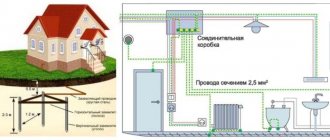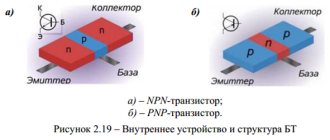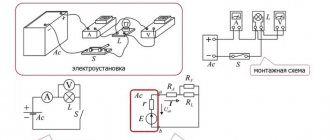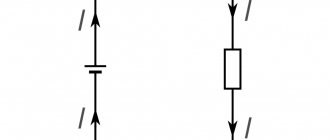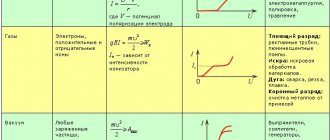Types of electric current sources
There are the following types of electric current sources:
- mechanical;
- thermal;
- light;
- chemical.
Mechanical sources
In these sources, mechanical energy is converted into electrical energy. The transformation is carried out in special devices - generators. The main generators are turbogenerators, where an electric machine is driven by a gas or steam flow, and hydrogenerators, which convert the energy of falling water into electricity. Most of the electricity on Earth is produced by mechanical converters.
Heat sources
Here thermal energy is converted into electricity. The occurrence of electric current is caused by the temperature difference between two pairs of contacting metals or semiconductors - thermocouples. In this case, charged particles are transferred from the heated area to the cold one. The magnitude of the current depends directly on the temperature difference: the greater this difference, the greater the electric current. Semiconductor-based thermocouples produce thermopower 1000 times greater than bimetallic ones, so current sources can be made from them. Metal thermocouples are used only for measuring temperature.
REFERENCE! To make a thermocouple, you need to combine 2 different metals.
Currently, new elements have been developed based on the conversion of heat released during the natural decay of radioactive isotopes. Such elements are called radioisotope thermoelectric generator. A generator using the plutonium-238 isotope has proven itself well in spacecraft. It produces a power of 470 W at a voltage of 30 V. Since the half-life of this isotope is 87.7 years, the service life of the generator is very long. A bimetallic thermocouple converts heat into electricity.
Designations of currents in measuring instruments
The generally accepted designation of direct and alternating current is reflected in various measuring instruments, including a multimeter. All necessary symbols are applied to the front panel of a particular device. This allows you to measure exactly the parameter that is needed at the moment.
For example, if the AC position is set on the scale, in this case the AC value can be measured. As a rule, such devices are designed to operate in electrical networks with conventional voltages of 220 or 380 volts. There are models with operating modes within 600 V and higher.
If the multimeter is set opposite the DC mark, then the operating mode of the device will correspond to direct current. In this position, the current is measured on batteries, batteries and other power sources that produce direct current. In this mode, it is imperative to observe the polarity of the poles. The measurement range is usually from zero to several thousand volts, depending on the characteristics of the specific modification of the device.
Ideal and real generator
It is assumed that in an ideal device the resistance due to internal characteristics is infinitely large. Because of this, the closed-loop network parameters do not affect the source. An unlimited increase in the resistance of an external electrical network connected to an ideal current device leads to an increase in the voltage at its terminals. It follows that the power increases, which can develop to an unlimited amount . Therefore, an ideal current generator can be considered as a source of infinite power.
The current-voltage characteristic (volt-ampere characteristic) of the energy converter is a straight line parallel to the coordinates U. In real sources, the current-voltage characteristic will intersect both axes. The intersection point corresponds to zero current and voltage. This mode of operation of devices is called idling.
Essentially, the ideal source is a physical abstraction. In fact, any electrical device has internal resistance. This parameter is inversely proportional to power. The equivalent circuit of a real source consists of two EMF generators connected in series. The voltage at the terminals is found as the sum of the potential difference across the internal resistance r and the load: E = ΔU + U.
Thus, the formulas describing the sources will be as follows:
- Ideal: U = I * R → P = I2 * R. Since for a current device the force of moving charges is constant, the voltage and power will increase without limit with increasing resistance.
- Real: U = I (R * r/ (R + r)) → P = I2 * (R / (1 + R/r)2. A device with internal resistance is equivalent to an EMF source.
Some semblance of an ideal current generator can be considered a device consisting of a battery and a large resistance connected in series to it. It might be a pentode (electronic tube). Possessing an internal resistance disproportionately higher than the impedance of the external closed circuit, these radio-electronic devices can deliver a current that practically does not change in magnitude.
Thus, these devices perform their main role in generating an electric field independent of the potential difference that appears in the external circuit.
What is the working principle of alternating current
The English abbreviation AC (Alternating Current) denotes a current that changes its direction and magnitude over time periods. The sinusoid segment “~” is its conventional marking on devices. Applying after this icon and other characteristics is also used.
Below is a figure with the main characteristics of this type of current - nominal frequency and operating voltage.
It should be noted the features of the change in the left graph, made for a single-phase current, in the magnitude and direction of the voltage with the transition to zero over a certain period of time T. For one third of the period, three sinusoids are shifted for a three-phase current on another graph.
O and “b” indicate phases. Any of us has an idea of the presence of 220V in a regular outlet. But for many it will be a discovery that the maximum or otherwise called amplitude value is greater than the acting value by an amount equal to the root of two and is 311 Volts.
Obviously, in the case of direct current, the parameters of direction and voltage remain unchanged, but for alternating current, a transformation of these quantities is observed. In the figure, the opposite direction is the area of the graph below zero.
It will be interesting➡ Connection diagram of the motion sensor to the spotlight
Let's move on to frequency. This concept means the ratio of periods (full cycles) to a conventional unit of time for a changing current. This indicator is measured in Hertz. The standard European frequency is 50, in the USA the applicable standard is 60G.
This value shows the number of changes in the direction of the current in one second to the opposite and return to the original state.
Alternating current is present when consumer devices are directly connected to electrical panels and sockets. For what reason is there no direct current here? This is done in order to be able to obtain the required voltage in any quantity by using transformers without any significant losses. This technique remains the best way to transmit power on an industrial scale over significant distances with minimal losses.
The rated voltage, which is supplied by powerful generators of power plants, at the output is about 330,000-220,000 Volts. At a substation located in the consumption area, this value is transformed to 10,000V with a transition to a three-phase version of 380 Volts. A separate house is supplied and single-phase voltage reaches your apartment. The voltage between zero and phase will be 220 V, and in the shield between different phases this figure is 380 Volts.
Why does the network have alternating voltage and not constant
Alternating current has many advantages over direct current. Low losses during the transmission of alternating current in power lines (power lines) compared to direct current. Alternators are simple and cheap. When transmitted over long distances along power lines, high voltage reaches 330 thousand volts with minimal current.
The lower the current in the power line, the lower the losses. Transmission of direct current over long distances will incur considerable losses. Also, high-voltage alternators are much simpler and cheaper. It is easy to get lower voltage from AC voltage through simple transformers.
Also, it is much cheaper to obtain DC voltage from AC voltage than, on the contrary, to use expensive DC-AC voltage converters. Such converters have low efficiency and high losses. Double conversion is used along the AC transmission path.
First, it receives 220 - 330 kV from the generator, and transmits it over long distances to transformers, which lower the high voltage to 10 kV, and then there are substations that lower the high voltage to 380 V. From these substations, the electricity is distributed to consumers and supplied to homes and electrical panels apartment building.
Three phases of three-phase current shifted by 120 degrees
Single-phase voltage is characterized by one sinusoid, and three-phase voltage is characterized by three sinusoids, offset by 120 degrees relative to each other. A three-phase network also has its advantages over single-phase networks. These are smaller dimensions of transformers, electric motors are also structurally smaller.
It is possible to change the direction of rotation of the rotor of an asynchronous electric motor. In a three-phase network, you can get 2 voltages - 380 V and 220 V, which are used to change the engine power and adjust the temperature of the heating elements. Using three-phase voltage in lighting, it is possible to eliminate the flickering of fluorescent lamps, for which they are connected to different phases.
Direct current is used in electronics and in all household appliances, since it is easily converted from alternating current by dividing it on a transformer to the required value and further straightening it. The source of direct current is batteries, batteries, direct current generators, LED panels. As you can see, the difference in alternating and direct current is considerable. Now we have learned - Why does our socket flow alternating current and not direct current?
DC Characteristics
Direct Current or DC in English means a similar variety, which has the inherent property of not changing its parameters over any period of time. A small horizontal line or two parallel lines with a line drawing of one of them is a graphic representation of direct current.
Scope of application: most models of household electrical appliances and electronic devices, including computer equipment, televisions and gadgets, use in home networks and cars. To convert alternating current into direct current in the outlet area, voltage transformers with rectifiers or specialized power supplies are used.
A common example of DC consumption is almost all power tools that operate with batteries. The battery device remains in any case a constant power source. Conversion to variable is achieved, if necessary, with the help of inverters - special elements.

